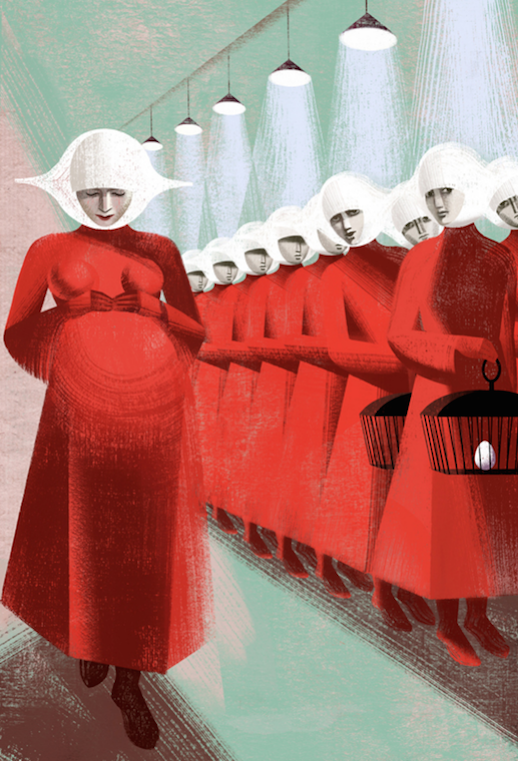This week’s book, record, and miscellaneous recommendations come from Jeff Barrett and Diva Harris of CBTR HQ, and long-serving contributor Andy Childs.
Diva Harris:
– Gazpacho from Garcia’s, a really good Spanish deli on Portobello Road which has been there since the 50s. The only lunch I want to go anywhere near in this ungodly heat.
– This mix from Swiss kraut babes Klaus Johann Grobe, which they’re calling PSYCHELDELIK HAAR JAZZ. Personally, I think the name alone should sell it to you. Nice to see that they’re still filling the world with good things, despite being on a break ’til 2018.
– Park Road Lido, Crouch End. An idyll.

Illustration by Anna + Elena Balbusso, for the 2012 Folio Society edition of ‘The Handmaid’s Tale’
Andy Childs:
– American Epic. Shown on BBC4, this long-awaited four-part history of the birth of recorded music in the U.S. doesn’t disappoint. The narrative is clear and gimmick-free, and the stunning quality of the stills and footage used is remarkable, even though, at times, they are used once or twice too often. I also found Robert Redford’s narration a tad mumbled sometimes – I would have chosen Peter Coyote, who did such a great job on Ken Burns’ The West. Nevertheless this is obviously a major series of historic importance. I haven’t watched the final part yet, which apparently consists of a curious array of contemporary artists performing and recording in the manner employed in the 1920s, and I’m sceptical. We’ll see. I was compelled enough though to splash out on the beautifully-compiled five-CD box set that accompanies the series and subsequently heard a nice little story that brought it all closer to home. The guardians of the EMI Archive here in the UK were, and I quote: “approached by one of the production company’s researchers. Seemingly in their detailed search for examples of some of the earliest and most important recordings of American popular song, country, blues, hillbilly etc., they found that a large number of them were in too poor a condition to be useable. Then someone told them that very early in its history, The Gramophone Company (the forerunner of EMI) struck a deal with RCA in America, whereby each company would share its recordings with the other. As result a copy of every recording by RCA was shipped to Hayes. Unsurprisingly, in those early years, The Gramophone Company was primarily if not exclusively interested in recordings by British singers and musicians, and the American discs were carefully stored away. By the time the music industry became interested in issuing recordings from its history, the link between EMI and RCA had long been severed and these thousands of discs remained unplayed and untouched in the Hayes vaults. Such was Amrican Epic’s delight in realising that we had pristine copies, they borrowed over 70 discs, which were carefully hand couriered to America, where they were copied and the results will feature strongly in the series. None of these recordings were EMI property, but the wisdom of the archive not to dispose of anything under its auspices is yet another illustration of its uniqueness!”
– American Gods. The number of TV series these days that have a plot that I find next to impossible to follow is increasing alarmingly. I gave up on the pretentious tosh that is the third series of Twin Peaks after episode three and am struggling with Mr.Robot. American Gods is baffling and disorientating and assumes you’ve primed yourself with background info and plot synopsis, and is plainly bonkers. But it’s also visually stunning, funny, fast-paced, brilliantly scripted, and it stars Ian McShane, whose knack for stealing every scene he’s in is only matched by Gillian Anderson. McShane as Al Swearengen in Deadwood is surely one of the immortal characters of TV westerns, and he brings all the menace and charisma of that character to American Gods, as well as a sharp sense of humour. I haven’t read the Neil Gaiman book that it’s based on (and probably never will), and I’ve only watched four episodes so far, but I’m hooked. It’s available on Amazon Prime.
– The Happy Reader. A collaboration between Penguin Books and independent publishing company Fantastic Man, The Happy Reader is a quarterly magazine which is free to subscribers (you only pay £2 p&p per issue). Every issue is split into two main parts. The first part is usually a long interview with a bookish celebrity, and the second part features essays tangentially connected to a particular book in the Penguin Classics catalogue. This new issue focuses on Treasure Island. The format is not as dry as I’ve possibly made it sound and it’s a good mag to dip in and out of.
– The Handmaid’s Tale – another book I haven’t read but probably should have done by now. The first three parts of the new ten-part TV adaptation have been so good though that I might just settle for the dramatised version. Actually I haven’t read anything by Margaret Atwood; I feel there’s only so much dystopian fiction one can handle without throwing in the towel. Especially when you know what you’re reading about is just around the corner.
– The Voices of…Andy Partridge – an interesting series of programmes on Radio 4. I particularly liked this one.
– Folk Horror by Adam Scovell. I read this review on Caught by the River, and decided I had to investigate.
Jeff Barrett:
– Just Another Jihadi Jane by Tabish Khair.
– TV-wise, Fargo. And The Art of Japanese Life: Nature, on BBC Four.
– Embalo by Tenório Júnior e seu Conjunto.
– Jimi Goodwin on Radio 4’s Tweet of the Day. There are two episodes, a minute or so each. One focuses on cuckoos, and the other on mallards.

